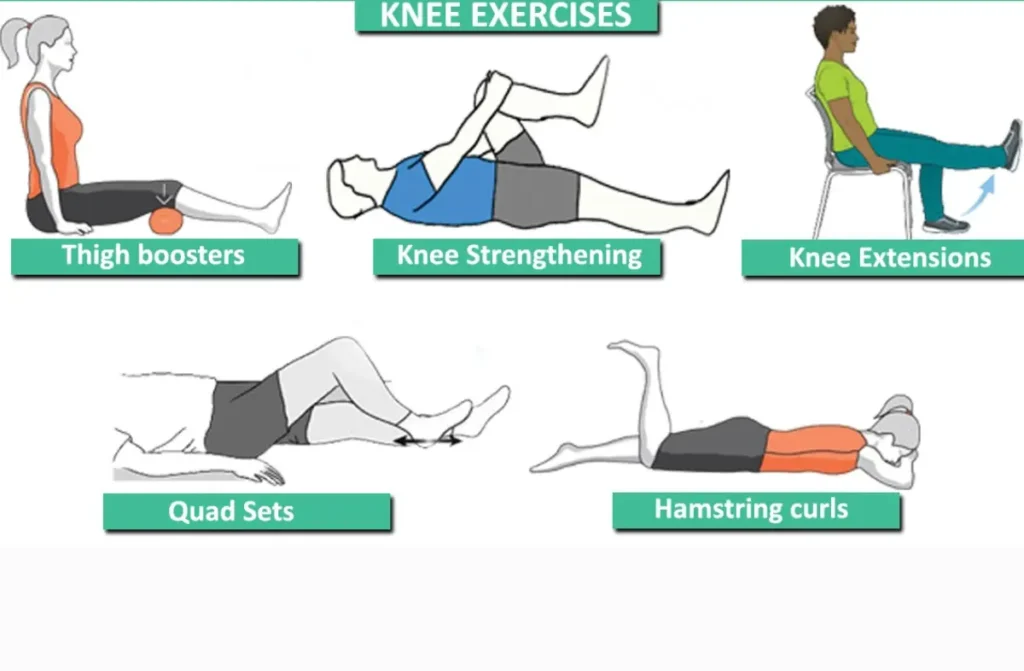If you’re dealing with knee pain, finding the right solution is key to maintaining your mobility and comfort. One of the most effective ways to manage this pain is by incorporating knee strengthening exercises for knee pain into your routine. These exercises help improve the muscles around the knee, providing better support and reducing pain over time. Knee strengthening exercises for seniors or younger, the regular knee exercises can make a big difference.
Knee Strengthening Exercises for Knee Pain
Knee strengthening exercises for knee pain can significantly improve your quality of life, especially if you’re dealing with discomfort from injury, arthritis, or overuse. These exercises not only strengthen the muscles but also improve flexibility and range of motion. In this blog, we’ll explore different exercises and tips on how to perform them safely. By following these exercises, you can manage your knee pain and prevent further issues.
How to Tell if You’re Exercising at the Right Level
When doing knee strengthening exercises for knee pain, it’s essential to ensure you’re working at the right intensity. You don’t want to push yourself too hard, but you also need to do enough to see results.
- Start with low-impact exercises and gradually increase the intensity.
- Listen to your body; if you feel sharp pain, stop and rest.
- A little discomfort is normal, but it should go away after exercise, not worsen.
How Many and How Often
Consistency is crucial when it comes to knee muscle exercises. How often you should perform these exercises depends on your fitness level and goals.
- Aim to exercise 3 to 4 times a week for the best results.
- Start with 10 to 15 repetitions for each exercise and gradually increase the number as your strength improves.
- Take rest days in between to allow your muscles to recover.
When to Stop
Knowing when to stop is essential to avoid further injury. If you experience severe pain, swelling, or your knee feels unstable, it’s time to stop and consult a doctor.
- Stop exercising if you feel sharp pain or hear a popping sound in your knee.
- Swelling or redness in the knee area is a sign that you should rest.
- If the pain persists for more than a day, it’s important to see a healthcare professional.
Benefits of Knee Strengthening Exercises for Knee Pain
Knee strengthening exercises are highly effective in managing and reducing knee pain. Here are some key benefits:
- Improved Joint Stability: Strengthening the muscles around the knee, such as the quadriceps, hamstrings, and calves, provides better support and stability, reducing strain on the joint.
- Enhanced Flexibility and Range of Motion: Regular exercises help maintain and improve knee flexibility, preventing stiffness and enhancing overall movement.
- Reduced Pain and Inflammation: Strengthening exercises can alleviate pain by reducing pressure on the knee joint and promoting better blood circulation.
- Increased Muscle Strength: Stronger muscles absorb more stress, reducing the load on the knee joint and preventing further damage.
- Better Balance and Coordination: Knee exercises enhance balance, lowering the risk of falls and injuries.
- Support for Recovery: For individuals recovering from surgery or injury, knee exercises aid in faster and more effective rehabilitation.
- Prevention of Future Issues: Regular knee strengthening can prevent conditions like osteoarthritis by maintaining joint health.
Incorporating knee exercises into your routine helps reduce pain, improve mobility, and promote long-term knee health.
Exercises for Knee Pain
Leg Lifts
Leg lifts are a great way to target the muscles around your knee without putting too much stress on the joint. This exercise is especially effective for knee strengthening exercises for seniors.
- Lie on your back with one leg straight and the other bent at the knee.
- Slowly lift your straight leg to a height of about 12 inches.
- Hold for a few seconds, then lower the leg slowly.
- Repeat 10 to 15 times for each leg.
Standing Hamstring Curls
Standing hamstring curls are an effective knee strengthening exercises for elderly that targets the back of the thighs. Exercises for hip and knee pain will Strong hamstrings can help relieve pressure on the knees.
- Stand with your feet hip-width apart and hold onto a chair or wall for support.
- Slowly bend one knee, bringing your heel toward your glutes.
- Hold for a few seconds before lowering your leg.
- Repeat 10 to 15 times for each leg.

Leg Extensions
Leg extensions help strengthen the quadriceps, which play a vital role in stabilizing the knee.
- Sit on a chair with your feet flat on the ground.
- Slowly extend one leg out straight and hold it for a few seconds.
- Lower the leg back down and repeat for the other leg.
- Perform 10 to 15 repetitions on each side.
Step Exercises
Step exercises are excellent for building strength and improving balance, making them a great addition to your routine.
- Use a step or a low platform. Step onto it with one leg while keeping the other foot on the ground.
- Step down and switch legs.
- Do this for 10 to 15 repetitions for each leg.
Single-Leg Dip
Single-leg dips are great for strengthening the muscles around your knee and improving balance.
- Stand on one leg and slowly lower your body into a mini squat, as if you’re dipping.
- Keep the other leg slightly off the ground.
- Return to the starting position and switch legs.
- Perform 10 to 15 repetitions on each leg.
Wall Squats
Wall squats are an excellent way to engage your quads, hamstrings, and glutes, all of which support the knees.
- Stand with your back against a wall and slowly slide down into a squat position.
- Hold for a few seconds and then slide back up.
- Repeat 10 to 15 times.
Post-Exercise Stretching
Stretching after doing knee strengthening exercises for knee pain helps to improve flexibility and prevent muscle tightness.
- Stretch your hamstrings, quads, and calves to keep the muscles around your knee flexible.
- Hold each stretch for at least 20 seconds.
- Avoid bouncing while stretching, as this can lead to muscle strain.
Safety Considerations
When doing knee strengthening exercises for elderly or anyone with chronic knee pain, safety should always be a priority.
- Always warm up before starting your exercise routine to prevent injury.
- Use a chair or wall for support if you feel unsteady during exercises.
- Consult your doctor for Physiotherapy treatment before starting any new exercise program, especially if you have a pre-existing condition.
How Exercising Helps Relieve Pain
Regular ” exercise for knee ” plays a key role in reducing knee pain and improving joint function. By strengthening the muscles around the knee, exercises such as squats and lunges help distribute forces evenly across the joint, reducing stress on the knee and improving stability.
- Best pain relief for arthritis: Incorporating knee exercises can be one of the best pain reliefs for arthritis. Strengthening the surrounding muscles reduces the impact of arthritis symptoms, alleviating pain and stiffness in the knee joint.
Improving Joint Health with Regular Exercise
Regular physical activity is vital for improving joint health. Consistent movement helps to lubricate the joint, promote muscle strength, and enhance flexibility, all of which are essential for reducing the risk of knee injuries.
- How exercise helps: Exercise for knee provides a safe and effective way to maintain joint function. By regularly engaging in strength-building activities, you reduce the chances of further injury and improve mobility.
Knee Exercises for Runners: Preventing Injuries and Enhancing Performance
For runners, knee exercises for runners are particularly important. Repetitive motion and impact from running can lead to knee problems, but targeted exercises can help protect the knees from injury and enhance overall performance.
- Why knee exercises are important for runners: Running places significant stress on the knees. The right exercises strengthen the muscles that support the knee, improve balance, and prevent injuries. Regular practice of exercise for knee is crucial to maintain optimal performance and reduce the risk of knee problems.
Prone Leg Raises for Knee Strength
Prone leg raises help strengthen the lower back, hip flexors, and quadriceps, all of which are essential for knee stability. This exercise also improves flexibility and range of motion, promoting better knee function. For those suffering from knee discomfort, it can serve as an effective part of the best pain relief for arthritis as it strengthens the muscles that support the joint and reduces strain.
- How to do it: Lie flat on your stomach with your legs extended behind you. Slowly raise one leg about 6–8 inches from the floor while keeping it straight. Hold for a few seconds, then lower it back down. Repeat for 10–15 reps on each leg.
- Benefits: Prone leg raises help improve flexibility, strengthen the muscles around the knee, and increase the range of motion. They are a great addition to your exercise for knee routine.
Conclusion
Knee strengthening exercises for knee pain are a simple yet effective way to manage knee discomfort and improve mobility. With the right exercises and proper technique, you can strengthen the muscles around your knee, support your joints, and prevent further pain. If you’re unsure about where to start, CTS Hospital can provide expert advice and guidance on exercises for hip and knee pain. Don’t hesitate to contact us for more information on how we can help you on your journey to better knee health.
